#Fermentation Process
Explore tagged Tumblr posts
Text
Cure (recipe at bottom)
100g of cure #1: 6.25g (6 250mg) sodium nitrite; 93.75g salt (sodium chloride).
10g cure 1: 0.625g (625mg) NaNO2; 9.375g salt.
1g: 0.0625g (62.5mg); 0.9375g.
Alright. If my recipe calls for 3g cure for every 1kg of meat, I am getting (62.5x3=)187.5mg nitrite/kg. If I am curing 4kg then it is (187.5x4=)750mg. If I am curing 500g then it is (187.5x0.5=)93.75mg nitrite.
100g of cure #2: 5.67g (5 670mg) sodium nitrite; 3.63g (3 630mg) sodium nitrate; 9.3 (9 300mg) both; 90.07g salt.
10g cure 2: 0.567g (567mg) nitrite; 0.363g (363mg) NaNO3; 0.93g (930mg) both; 9.07g salt.
1g: 0.0567 (56.7mg) ite; 0.0363g (36.3mg) ate; 0.093g (93mg) both
If my recipe calls for 3g of cure for every 1kg of meat, I am getting 170.1mg nitrite/kg & 0.1089g nitrate/kg, or 279mg both/kg.
EU regulation says 150mg. Good thing I'm in Canada.
Alright so, celery leaf.
"Cold-smoked sausages containing 2.58% of freeze-dried celery (corresponding to 150 mg/kg of nitrate) or 150 mg/kg nitrite or 150 mg/kg nitrate were manufactured with S. xylosus or with S. xylosus and P. pentosaceus mixture."
This seems to imply that they cured meat with normal 150mg nitrate, then they cured meat with 150mg nitrate in the form of celery, & they cured meat with 150m nitrite. To get 150mg nitrate in the form of celery, they needed 25.8g of freeze dried celery powder.
According to my assumptions, there are 150mg of nitrate in 25.8g celery powder.
Celery Total Nitrate Content (mg kg−1[which means ppm or mg/kg]): 1103, 1544, 1495, according to different sources
That is for fresh celery & not dried celery leaves. How much weight does celery lose when dried? If I wanted to do the math, I would find a conversion for something like parsley leaves weight fresh vs dry & celery fresh vs freeze dried. Either that or multiply away the water weight from celery.
"The five different sausage formulations were: Control negative (CN) no nitrate added; Control positive (CP) 150 mg/kg potassium nitrate; Group with celery powder (GSe) 3 g/kg celery powder. Based on Sindelar et al. (2006), a mild effect on the colour of the meat was expected from celery and spinach, and beet powder was added in two lots."
So here it seems like they are treating 3g of celery as equivalent to 150mg nitrate.
This is a far cry from 26g of celery equivalent to 150mg.
Celery is 95% water. According to my brother, dry celery has 14 000mg (14g) of nitrate in one kilo.
If I need 279mg of nitrates/ites for one kilogram of meat, how many grams of dried celery powder do I need?
279 is basically 280mg. I need 20grams of dried celery.
So without further ado, here is my recipe:
For every kilogram of meat you want to cure, you need the following:
Salt: 25g (& an extra 3g from cure 2)
Cure 2: 3g (280mg nitrate/ite, 2.7g salt); ALTERNATIVELY - Dried celery leaf powder: 20g
Dry sage: 0.9g
Rosemary: 0.6g
Fennel seed: 1g
Ground fennel: 1g
White pepper: 0.3g
Garlic powder: 0.5g
Chianti (italian/tuscan red wine from sangiovese grape)
Mixing vessel, something with which to open the chianti, gram scale, fridge/cooler, plastic bag/vacuum seal bag, probably a tray or smth to do this on.
Keep all the parts apart until you are ready to mix. You'd be surprised how often you forget that you already did a part of it. Phone rings? Oh now where was I. Did I already get the salt? Hmm...
Weigh the meat you want to cure. Multiply each number by how many kilos of meat you have. Measure the ingredients all apart.
Wet with wine until it is like sand at the beach. Pack on all the salt mix. Do not waste any because this is already measured for this amount of meat. Put it into the bag & seal.
Store in the fridge for a few weeks up to a few months.
When ready, I would suggest using a thermocirculator to low-temperature pasteurize it, & then it is safe to store for another few months.
(Here is what my teacher said: Yes, once we cured the whole muscle, we store it under refrigeration to cure through. Depending on the cut and temp, that's usually about 3-4 weeks for the Coppa and 2-3 for the lomo, as reference. You can keep it vac sealed with the curing ingredients for months. Max I've done personally is 5 months. After the curing phase, I cooked them sous vide. And it's neat because once it's been cooked sous vide, the shelf life in the fridge is then also months.)
#cured meats#cured meat#culinary school#culinary#meat processing#lomo#coppa#capicola#food preservation#fermentation process#recipe#recipes#meat recipe#whole muscle cure#whole muscle recipe
3 notes
·
View notes
Text

How Fermented Foods Help Fight Diabetes
Fermented foods offer many health benefits, and this is another big reason why fermented dishes are so common in Asian countries. fermented foods are an integral part of the Indian menu too. Fermented food helps diabetics in maintaining the gut bacteria.
Read more: https://www.freedomfromdiabetes.org/blog/post/how-fermented-foods-help-fight-diabetes/1551
#what is fermentation#fermentation process#Indian fermented foods#benefits of fermented foods#probiotic foods#fermented foods and diabetes
0 notes
Link
Ready to transform from a baking beginner to a confident home baker? 🍞🍰 Dive into our guide on "Baking with Yeast: A Step-by-Step Guide for Beginners" and unlock the secrets to crusty bread, fluffy pastries, and more with yeast baking. Your kitchen adventures await! 🌟 #BakingWithYeast #HomeBaking #BakingGuide
0 notes
Text
The Art of Alcohol: What's Your Poison?
Alcohol has been a part of human culture for millennia. Over time, different regions have perfected the art of fermenting and distilling various ingredients to produce a delightful array of beverages. Let’s embark on a journey to understand the detailed preparation and the unique taste profiles of some of the world’s most popular alcoholic drinks. BEER PreparationBeer’s primary ingredients are…

View On WordPress
#aging barrels#alcohol ingredients#alcohol preparation#alcoholic beverages#beer brewing#distilling techniques#drink connoisseur#drink flavors#fermentation process#gin botanicals#rum production#taste profiles#tequila from agave#vodka distillation#whiskey aging#wine fermentation
0 notes
Photo
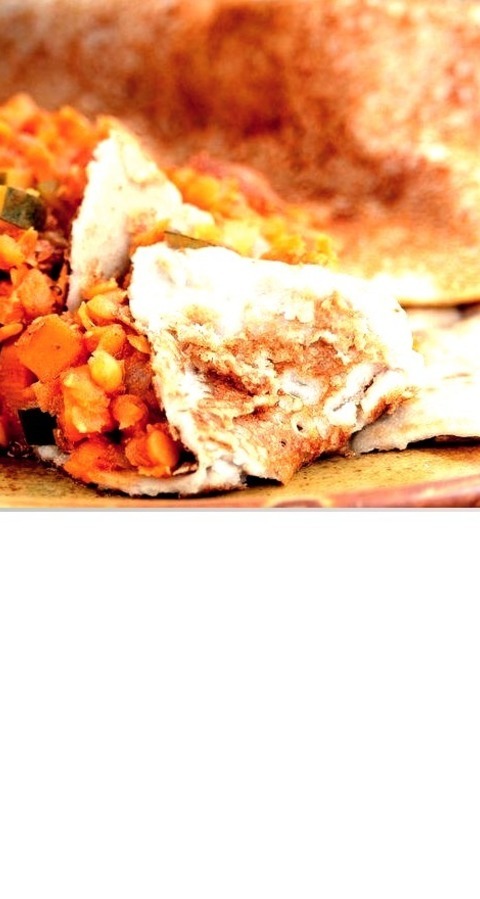
Injera Ethiopian Teff Bread A naturally fermented, spongy, gluten-free flatbread from Ethiopia is made from teff flour and water, using wild yeast to ferment over a couple of days.
0 notes
Photo
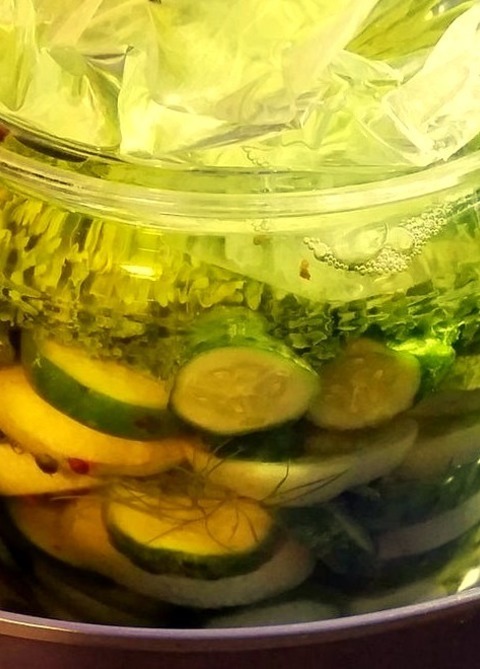
Garlic and Dill Lacto-Fermented Pickles Recipe Cucumbers that have been lacto-fermented at home are simple to make and are nice to have on hand to serve guests or give as a gift when eating at a friend's house. 3 cups washed mustard greens or as needed, 3/4 cup sea salt, 1 head garlic cloves separated and peeled, 1 gallon spring water, 5 pounds fresh pickling cucumbers, 2 large onions cut into rings, 6 medium heads fresh dill, 3 tablespoons whole mustard seeds, 6 large bay leaves, 2 tablespoons red pepper flakes, 5 tablespoons whole black peppercorns, 3 pieces peeled horseradish root
0 notes
Text





Leverage 5x1- "The (Very) Big Bird Job"
#christian kane#leverage#eliot spencer#alec hardison#aldis hodge#parker#beth riesgraf#nathan ford#timothy hutton#sophie devereaux#gina bellman#the (very) big bird job#p.s. the beer fermentation process typically takes one to three weeks#hardison WHY are you not reading the books
42 notes
·
View notes
Text

Dissociated
#invader zim#zim#dib#its one of those nights again#my art#where i remember my first invader zim phase ever when i first discovered it#when nothing but invader zim felt real#or safe#when i felt so ashamed for shipping#when middle school made my life impossible to live#when i copied the art style and felt like an impostor for not being able to go back to making cute art#when my art changed direction for the first time and i had no idea what to do with it#when i felt like i lost everything#when i wished i was dead and the only thing to help me cope were edgy amvs#im so grateful its over and i reclaimed as much of that as i could#im so happy i can do this now and harness different styles#im so happy i managed to get back into iz despite seemingly being over it at first#i didnt want to stop making memories with this show and leave it in the past#reexposing myself to what i associated with it and that horrible time helped me both reconnect with the show again and process#fermented stuff#im so happy#positive vent#art related / rambles
31 notes
·
View notes
Note
my mother has asked me to ask “that weaver friend of yours” lol — do you have experience dyeing linen? what does the process look like for natural vs synthetic dyes?
happy to be that weaver friend of yours 🥰❤️ dyeing linen is basically the same as dyeing cotton or any other cellulose fiber, so any synthetic dye that works for cotton will also work for linen. a professional grade fiber reactive dye like procion mx or dharma's procion (here) dyes cellulose fiber without heat, and the process is quick and painless. it just involves a large bucket, water, the dye powder and the cloth you wish to dye. i have little experience with rit dye so i'm not sure if you'd need heat for that, but procion dye is higher quality, comes in a lot more colours than rit, and a 2oz container is like $2 usd and goes a long way
the natural dye process for linen takes a lot longer than the procion dye process and requires several steps. cellulose fibers really don't like to take dyes so you basically have to do a bunch of alchemy to convince it to do what you want (compared to protein fibers like wool and silk which love dyes and only need some gentle nudges)
naturally dyeing linen depends on the dye you'd wish to use, but the process is essentially: scouring, mordanting, and dyeing. it's really important that you scour linen especially because it contains a lot of pectins that prevent dye from penetrating the fiber, so a harsh scouring is best (ie. washing it with hot water and ph neutral soap, even to the point of boiling the cloth. linen can take a lot of heat and is better for it, cotton is more sensitive) you'll probably have to do this before dyeing it with the synthetic dye too for best results
most natural dyes require that you mordant the cloth before dyeing. some dyes don't require a mordant (indigo is the big one, but if you're working with onion skins or other materials that contain tannins this is also true. however mordanting the cloth before dyeing with tannins or even mordanting with tannins is still recommended for better colour performance long-term unless you're working with indigo in which case using a mordant can actually cause problems) but if you're unsure, assume that you need to apply a mordant. you essentially have to simmer the cloth in a hot pot with either a material that contains tannins (tannic acid), a natural bio-accumulator of aluminum (symplocos), or use a metal salt (alum acetate is best for cellulose, but iron and copper salts can also be used. the metal salts route requires more safety precautions esp if you use copper salt, you can't dump that down the drain) your choice of mordant impacts the final colour with different mordants shifting the chemical reaction that happens in the cloth when you dye it
with cotton and linen, after you use the mordant you need to use either a chalk or wheat bran bath to remove excess mordant from the cloth, esp if you use alum acetate, otherwise it can leave a whitish cast over the cloth and also impede dyeing lol. wheat bran baths tend to cause a warmer tone to the final dyed cloth, chalk baths cause a cooler tone. i only use wheat bran baths bc i prefer the warmth and i get the bran cheaply at my local punjabi grocer
only then can you dye the cloth, again unless you're working with a dye like coffee or tea or onion skins OR indigo. linen really doesn't like to take natural dyes unless you do all the above steps, it's stubborn. the dye process itself depends on what dye you use and you can do stuff like solar dyeing if you don't want to simmer it in a pot on a stove. if you plan to go the natural dye route lmk and i can send you some scans of a book i have that contains precise instructions for preparing linen for dyeing
#fun fact the word for mordant in bahasa (both msia and indonesia) is mordan lol#i love when stuff like that happens. like computer in bahasa msia being komputer#as a caveat these are the western steps for natural dyeing there are other approaches that include the same chemical processes#but dif techniques like ex. in malaysia/indonesia mordants and dye baths are fermented for several weeks to months#and the fermentation makes it so they can be used cold and you only have to dip them in the baths rather than simmer#but that takes even longer than the western methods and is less documented in an instructional sense so the western approach is easier
45 notes
·
View notes
Text
Day 3 of my red cabbage fermentation! Some very slight bubbling, not much, but the taste is starting to change. I added just a quarter teaspoon more salt (I may have under-done it), and massaged it for a bit before adding a clean weight to keep the cabbage under the brine, and then re-sealed it with a breathable cloth (listen I used paper towel it's convenient and I'm out of reusable cheesecloth).
High hopes! Salt level seems fine, no signs of mold or harmful bacteria. Hoping the slightly higher salt content helps. I should have weighed the salt instead of measuring it, but my scale's out of batteries. Lol.
I'm not sure what I'll use it on, I was thinking homemade spicy fried chicken sandwiches might be tasty.
#thea talks#I didn't ever really fuck with fermentation before but hey if every culture on earth has some form of it#it's obviously for a reason#I grew up poor but like white pretending to be middle class poor#so we wouldn't touch poor people food because then people would know we were poor so#lots of cheap processed food#which was such a hard habit to break once I was on my own
9 notes
·
View notes
Text
Today I started the experiment!
Filled up a black bucket with 2l of distilled water and 50g of raw fleece! Now we wait for the warmth and microbes to do the rest!
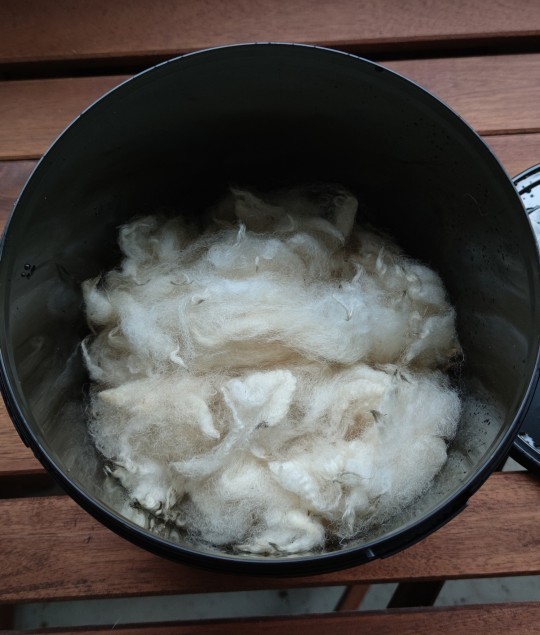
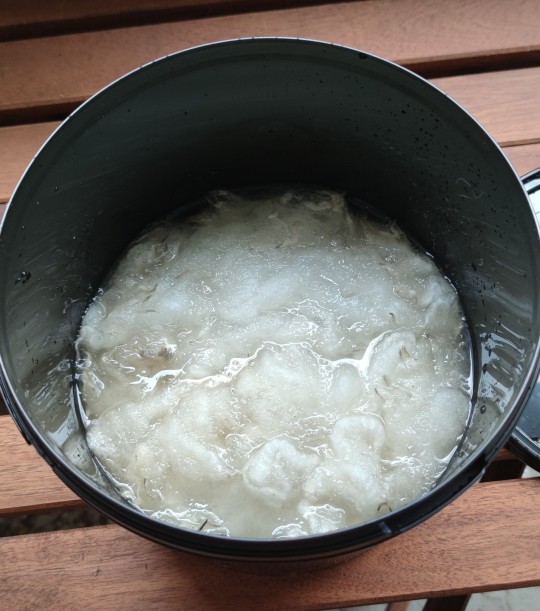
And
100g washed with power scour from unicorn fiber
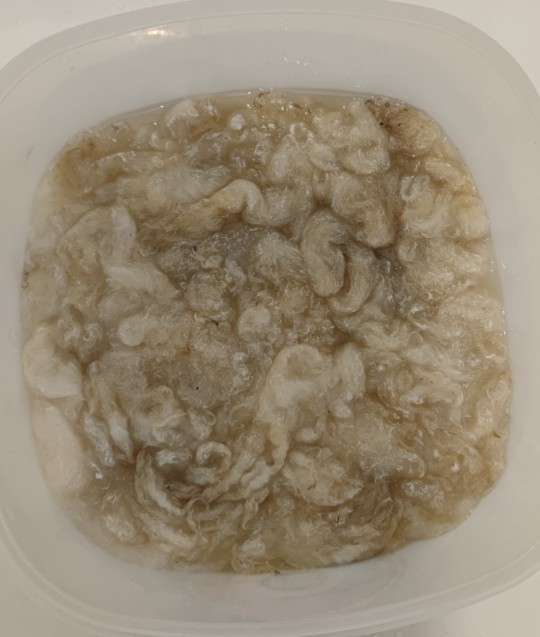

I used 3.8ml of power scour on 2 liters of water 47°C for 100g raw fleece, and needed to rinse 4 times with 2 liters of water roughly 38 to 40°C each time.
Geels, looks and smells already very clean. Vegeta let matter will be carded and combed out later
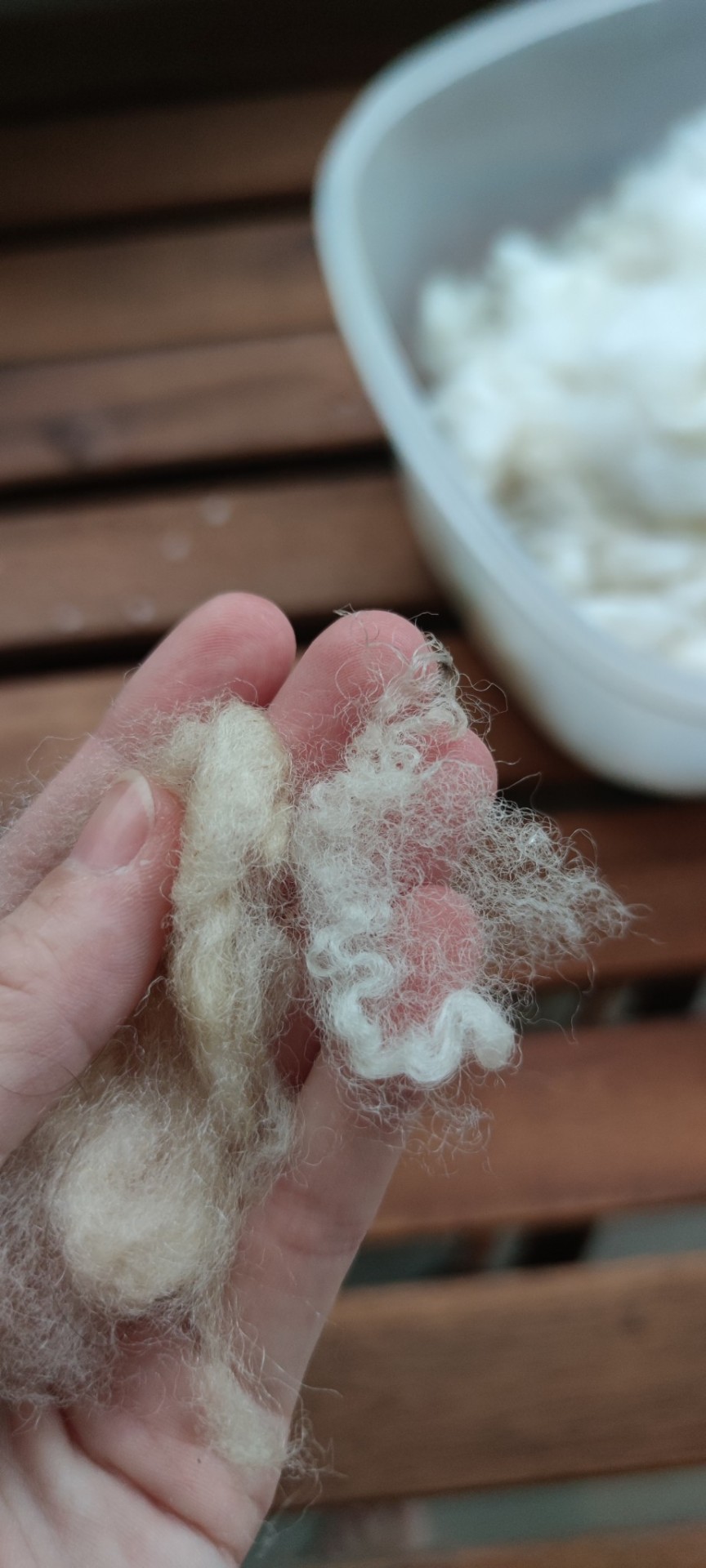
(left raw fleece and left from the washed fleece)
87 notes
·
View notes
Text
Chef WK, lead charcuterie specialist in Alberta Canada
Table of contents
1. Control Program Requirements for Fermented Meat Products
2. Facility and Equipment Requirements
3. Starter Culture
4. Chemical Acidification
5. Water Activity Critical Limits
6. Time and Temperature for Fermented Products
7. Fermentation Done at a Constant Temperature
8. Examples of Degree-hours at constant room temperatures
9. Fermentation Done at Different Temperatures
10. Fermentation done at Different temperatures
11. What happens if fermentation fails to hit critical limit?
12. E. coli and Salmonella Control in Fermented Sausages
13. Options for E. coli validation
14. Option1; Heating
15. Option 2; pH, heating, holding, diameter
16. Safety and consistency
Control Program Requirements for Fermented Meat Products
The producer must have a program in place to assess the incoming product. This program should outline specifications for the incoming ingredients. This may include criteria including receiving temperature, farm/ supplier, lot code or packed on date, species/cut etc.
2. Facility and Equipment Requirements
Equipment used in the fermentation process must be included in the operator's prerequisite control programs. These must include the following elements:
Temperature in the fermentation, drying and smoking chambers must be uniform and controlled to prevent any fluctuation that could impact on the safety of the final product.
Fermentation, drying and smoking chambers must be equipped with a shatter resistant indicating thermometer, (or equivalent), with graduations of 1°C or less. If mercury thermometers are used, their mercury columns must be free from separations. All thermometers must be located such that they can be easily read.
Fermentation and smoking chambers must be equipped with a recording thermometer for determining degree-hours calculations in a reliable manner. Recording thermometers are also preferable in drying and aging rooms but, in these rooms, it may be sufficient to read and record the temperatures 2 times a day.
Drying and aging rooms must be equipped with humidity recorders in order to prevent uncontrolled fluctuations of the relative humidity. The only alternative to an automatic humidity recorder in these rooms would be for the company to manually monitor and record ambient humidity twice a day (morning and afternoon) every day with a properly calibrated portable humidity recorder.
For routine monitoring, accurate measurement electronic pH meters (± 0.05 units) should be employed. It is important that the manufacturer's instructions for use, maintenance and calibration of the instrument as well as recommended sample preparation and testing be followed.
When the aw of a product is a critical limit set out in the HACCP plan for a meat product, accurate measurement devices must be employed. It is important that the manufacturer's instructions for use, maintenance and calibration of the instrument be followed.
3. Starter Culture
The operator must use a CFIA approved starter culture. This includes Freeze-dried commercially available culture as well as back-slopping (use of previously successful fermented meat used to inoculate a new batch). When performing back-slopping, the operator must have a control program in place to prevent the transmission of pathogens from when using the inoculum from a previous batch to initiate the fermentation process of a new batch. These must include:
The storage temperature must be maintained at 4°C or less and a pH of 5.3 or less.
Samples for microbiological analysis must be taken to ensure that the process is in line with the specifications.
The frequency of sampling is to be adjusted according to compliance to specifications.
Any batch of inoculum which has a pH greater than 5.3 must be analysed to detect at least Staphylococcus aureus. Only upon satisfactory results will this inoculum be permitted for use in back slopping.
This can be an expensive and a time exhaustive process and is generally avoided due to food safety concerns. AHS does not allow back-slopping.
[Chef WK was in communication with the U of A to get his method, a starter mix, studied.]
4. Chemical Acidification
If product is chemically acidified by addition of citric acid, glucono-delta-lactone or another chemical agent approved for this purpose, controls must be in place and records kept to ensure that a pH of 5.3 or lower is achieved by the end of the fermentation process. These acids are encapsulated in different coatings that melt at specific temperatures, which then release the powdered acids into the meat batter and directly chemically acidulate the protein.
Summer sausage is a very common chemically acidified product. The flavor profile tends to be monotone and lacking depth.
5. Water Activity Critical Limits
The aw may be reduced by adding solutes (salt, sugar) or removing moisture.
Approximate minimum levels of aw (if considered alone) for the growth of:
molds: 0.61 to 0.96
yeasts: 0.62 to 0.90
bacteria: 0.86 to 0.97
Clostridium botulinum: 0.95 to 0.97
Clostridium perfringens: 0.95
Enterobacteriaceae: 0.94 to 0.97
Pseudomonas fluorescens: 0.97
Salmonella: 0.92 - 0.95
Staphylococcus aureus: 0.86
parasites: Trichinella spiralis will survive at an aw of 0.93 but is destroyed at an aw of 0.85 or less.
The above levels are based on the absence of other inhibitory effects such as nitrite, competitive growth, sub-optimum temperatures, etc., which may be present in meat products. In normal conditions, Staphylococcus aureus enterotoxins are not produced below aw 0.86, although in vacuum packed products this is unlikely below aw 0.89.
6. Time and Temperature for Fermented Products
Certain strains of the bacteria Staphylococcus aureus are capable of producing a highly heat stable toxin that causes illness in humans. Above a critical temperature of 15.6°C, Staphylococcus aureus multiplication and toxin production can take place. Once a pH of 5.3 is reached, Staphylococcus aureus multiplication and toxin production are stopped.
Degree-hours are the product of time as measured in hours at a particular temperature multiplied by the "degrees" measured in excess of 15.6°C (the critical temperature for growth of Staphylococcus aureus). Degree-hours are calculated for each temperature used in the process. The limitation of the number of degree-hours depends upon the highest temperature in the fermentation process prior to the time that a pH of 5.3 or less is attained.
The operator is encouraged to measure temperatures at the surface of the product. Where this is not possible, the operator should utilize fermentation room temperatures. The degree hour calculations are based on fermentation room temperatures. Temperature and humidity should be uniform throughout the fermentation room.
A process can be judged as acceptable provided the product consistently reaches a pH of 5.3 using:
fewer than 665 degree-hours when the highest fermentation temperature is less than 33°C;
fewer than 555 degree-hours when the highest fermentation temperature is between 33° and 37°C; and
fewer than 500 degree-hours when the highest fermentation temperature is greater than 37°C.
This means that as the temperature increases, the amount of time that you have available to reach 5.3 or under is shorter. The warmer the temperature, the sharper the log growth phase of bacteria, which equates to more overshoot in lactic acid production, faster.
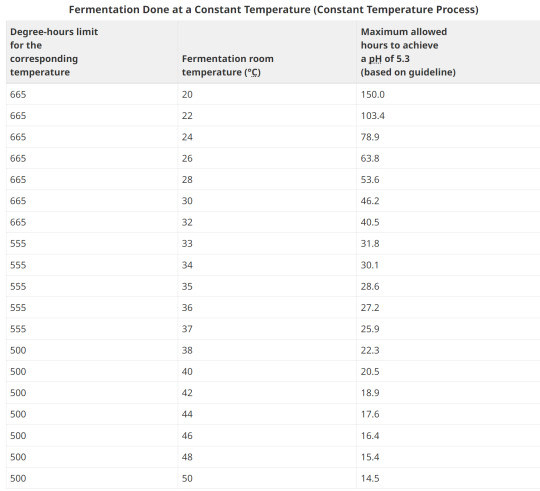
8. Examples of Degree-hours at constant room temperatures
Example 1:
Fermentation room temperature is a constant 26°C. It takes 55 hours for the pH to reach 5.3.
Degrees above 15.6°C: 26°C - 15.6°C = 10.4°C Hours to reach pH of 5.3: 55 Degree-hours calculation: (10.4°C) x (55) = 572 degree-hours
The corresponding degree-hours limit (less than 33°C) is 665 degree-hours.
Conclusion: Example 1 meets the guideline because its degree-hours are less than the limit.
Example 2:
Fermentation room temperature is a constant 35°C. It takes 40 hours for the pH to reach 5.3.
Degrees above 15.6°C: 35°C - 15.6°C = 19.4°C Hours to reach pH of 5.3: 40 Degree-hours calculation: (19.4°C) x (40) = 776 degree-hours
The corresponding degree-hours limit (between 33 and 37°C) is 555 degree-hours.
Conclusion: Example 2 does not meet the guideline because its degree-hours exceed the limit
9. Fermentation Done at Different Temperatures
When the fermentation takes place at various temperatures, each temperature step in the process is analyzed for the number of degree-hours it contributes. The degree-hours limit for the entire fermentation process is based on the highest temperature reached during fermentation.
Example 1:
It takes 35 hours for product to reach a pH of 5.3 or less. Fermentation room temperature is 24°C for the first 10 hours, 30°C for second 10 hours and 35°C for the final 15 hours.
Step 1
Degrees above 15.6°C: 24°C - 15.6°C = 8.4°C Hours to reach pH of 5.3: 10 Degree-hours calculation: (8.4°C) x (10) = 84 degree-hours
Step 2
Degrees above 15.6°C: 30°C - 15.6°C = 14.4°C Hours to reach pH of 5.3: 10 Degree-hours calculation: (14.4°C) x (10) = 144 degree-hours
Step 3
Degrees above 15.6°C: 35°C - 15.6°C = 19.4°C Hours to reach pH of 5.3: 15 Degree-hours calculation: (19.4°C) x (15) = 291 degree-hours
Degree-hours calculation for the entire fermentation process = 84 + 144 + 291 = 519
The highest temperature reached = 35°C
The corresponding degree-hour limit = 555 (between 33°C and 37°C)Conclusion: Example 1 meets the guideline because its degree-hours are less than the limit.
10. Fermentation done at Different temperatures
Example 2:
It takes 38 hours for product to reach a pH of 5.3 or less. Fermentation room temperature is 24°C for the first 10 hours, 30°C for the second 10 hours and 37°C for the final 18 hours.
Step 1
Degrees above 15.6°C: 24°C - 15.6°C = 8.4°C Hours to reach pH of 5.3: 10 Degree-hours calculation: (8.4°C) x (10) = 84 degree-hours
Step 2
Degrees above 15.6°C: 30°C - 15.6°C = 14.4°C Hours to reach pH of 5.3: 10 Degree-hours calculation: (14.4°C) x (10) = 144 degree-hours
Step 3
Degrees above 15.6°C: 37°C - 15.6°C = 21.4°C Hours to reach pH of 5.3: 18 Degree-hours calculation: (21.4°C) x (18) = 385.2 degree-hours
Degree-hours calculation for the entire fermentation process = 84 + 144 + 385.2 = 613.2
The highest temperature reached = 37°C
The corresponding degree-hour limit = 555 (between 33°C and 37°C)
Conclusion: Example 2 does not meet the guidelines because its degree-hours exceed the limit.
11. What happens if fermentation fails to hit critical limit?
What happens if the batch takes longer than degree-hours allows? For restaurant level production, it's always safer to discard the product. The toxin that Staph. Aureus produces is heat stable and cannot be cooked to deactivate. In large facilities that produce substantial batches, the operator must notify the CFIA of each case where degree-hours limits have been exceeded. Such lots must be held and samples of product submitted for microbiological laboratory examination after the drying period has been completed. Analyses should be done for Staphylococcus aureus and its enterotoxin, and for principal pathogens, such as E. coli O157:H7, Salmonella, and Clostridium botulinum and Listeria monocytogenes.
If the bacteriological evaluation proves that there are fewer than 104 Staphylococcus aureus per gram and that no enterotoxin or other pathogens are detected, then the product may be sold provided that it is labelled as requiring refrigeration.
In the case of a Staphylococcus aureus level higher than 104 per gram with no enterotoxin present the product may be used in the production of a cooked product but only if the heating process achieves full lethality applicable to the meat product.
In the case where Staphylococcus aureus enterotoxin is detected in the product the product must be destroyed.
12. E. coli and Salmonella Control in Fermented Sausages
Business' that manufacture fermented sausages are required to control for verotoxinogenic E. coli including E. coli O157:H7 and Salmonella when they make this type of product. This includes:
establishments which use beef as an ingredient in a dry or semi-dry fermented meat sausage;
establishments which store or handle uncooked beef on site;
Establishments which do not use beef and do not obtain meat ingredients from establishments which handle beef are not currently required to use one of the five options for the control of E. coli O157:H7 in dry/semi-dry fermented sausages.
Any processed RTE product containing beef or processed in a facility that also processed beef, must be subjected to a heat treatment step to control E. coli O157:H7. Heating to an internal temperature of 71°C for 15 seconds or other treatment to achieve a 5D reduction is necessary. This is a CFIA requirement and is not negotiable.
Uncooked air dried products produced as RTE, must meet shelf stable requirements as detailed for Fermented-Dry products.
13. Options for E. coli validation
Without lab testing, the two main methods of validation are with heat treating by either low temp and a long duration, or various hotter processing temperatures for a shorter timeframe.
A challenge study to validate a process can take 1 year and over $100,000!
14. Option1; Heating
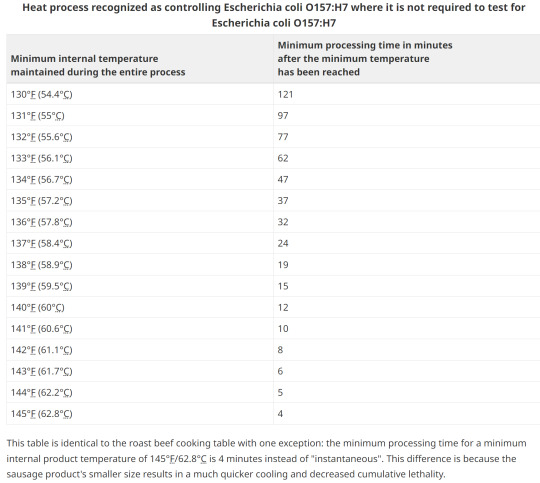
15. Option 2; pH, heating, holding, diameter
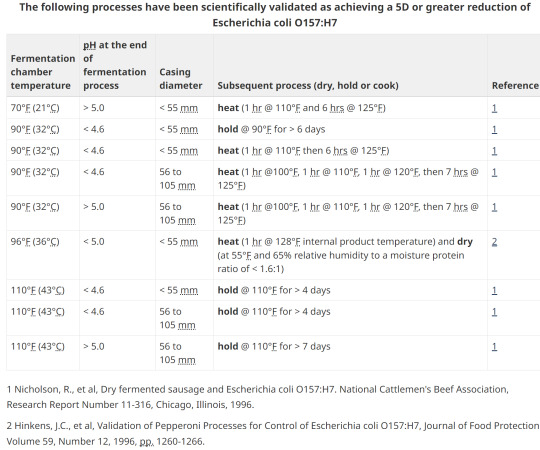
16. Safety and consistency
The aw and pH values are critical in the control of pathogens as well as to ensure shelf-stability in all semi-dry and dry fermented meat products. Each batch must be tested for aw and/or pH in order to verify that the critical limits are met.
Although aw measurement is mandatory only for shelf stable products, it is strongly recommended that the producer determine the aw values achieved for each product type they manufacture and for each product. Once this has been established, frequent regular checks should be made to ensure consistency. In the U.S., they rely on moisture to protein ratio and have set targets. This lab-tested value is a direct correlation of the % water to % meat protein and not aw. This gives more consistency to common names. For example, to legally call a product "jerky" it must have a MPR of 0.75:1 or lower. Remember your ABCs:
Always be compliant.
-AND-
Documentation or it didn't happen.
(tags)
Charcuterie,Fermented Meat,Food Safety,Starter Culture,Chemical Acidification,Water Activity,Fermentation Process,Degree-Hours Method,Foodborne Pathogens,Meat Processing Guidelines,Chef WK Alberta Canada,Food Industry Standards,pH Critical Limits,Thermal Processing,Food Preservation,Food Microbiology,Sausage Fermentation,Charcuterie Expertise,Fermented Meats ,Food Safety Standards,Food Processing Guidelines,Starter Cultures,Chemical Acidification,Water Activity (a_w),Critical Limits,Degree-Hours Method,Foodborne Pathogens,Meat Processing Equipment,Processing Facility Requirements,Hazard Analysis and Critical Control Points (HACCP),Food Preservation Techniques,Temperature Control,Pathogen Reduction,Food Industry Compliance,Documentation Practices,Heat Treatment,pH Control,Food Stability,Consistency in Production,Microbial Testing,Real-time Monitoring,Process Validation,Regulatory Requirements,Verotoxigenic E. coli,Lethality Standards,Product Labelling,Spoilage Prevention,Enterotoxin Detection,Shelf-Stable Products,Moisture to Protein Ratio (MPR)
#Charcuterie#Fermented Meat#Food Safety#Starter Culture#Chemical Acidification#Water Activity#Fermentation Process#Degree-Hours#Meat Processing Guidelines#Thermal Processing#Food Preservation#Food Microbiology#Sausage Fermentation#Starter Cultures#Critical Limits#Meat Processing#Food Preservation Techniques#Temperature Control#Pathogen Reduction#Food Industry#Heat Treatment#pH Control#Food Stability#Microbial Testing#Real-time Monitoring#Process Validation#Spoilage Prevention#Enterotoxin Detection#Shelf-Stable Products#Moisture to Protein Ratio (MPR)
2 notes
·
View notes
Photo

Soy sauce processing, Hanoi by Sabina BD
4 notes
·
View notes
Note
I know we're on a bagel kick around here however the idea of spider fool drinking a single drop of a monster energy drink and seeing god for the first time hasn't left my mind I think the little crecher would enjoy it
I was talking to a friend earlier about how they prolly could handle like, a spicy chip like a takis or something but prolly couldn’t survive anything carbonated
#idk if there’s any carbonation in like#the natural process of fermentation like they would have in ale or mead back then but I’m assuming it’s not like soft drink levels right??#like nowadays#ask
58 notes
·
View notes
Text
I think having a moment where I play sudoku while lost in thought as I listen to music is essential to my creative process
#my ramblings#rouge on air#<- liveblog tag as i liveblog sudoku#i do genuinely think it is important to settle time to deliberate on certain things (essentially a fermentation process in a sense?)#how i go about that is by playing sudoku but it does generate sparks of “aha!” moments
3 notes
·
View notes
Text
the vegans found my stupid post again
#a person commented: 'not everyone can eat plant based but everyone can be vegan' im...#im seriously trying SO. so hard to give this person the benefit of the doubt but. WHAT#lately ive working on fungi based alternatives for food but even THEN most of it is using food to ferment plants and algae#to get the most of it you know?#but like WHAT ELSE ARE WE GOING TO EAT#rocks????#DIRT????#eating animals is not some terrible moral failing. just be aware of the fucking process and try to reduce unnecessary consumerism#do people not know about the 3 R?? do they not teach that in school anymore??#anyway im so tired please leave me the fuck alone
23 notes
·
View notes